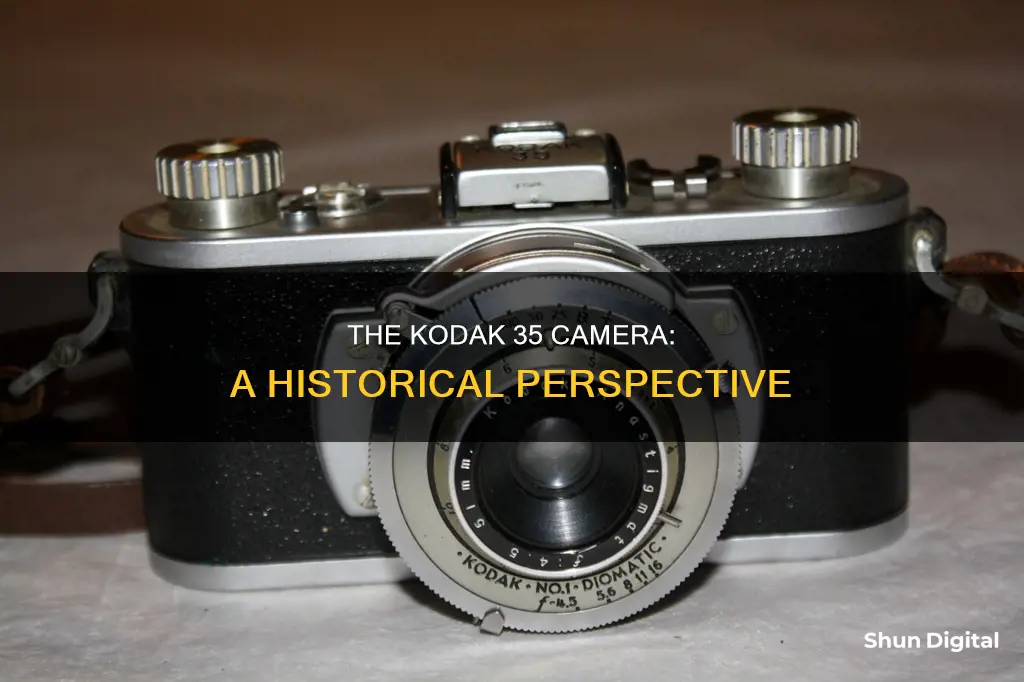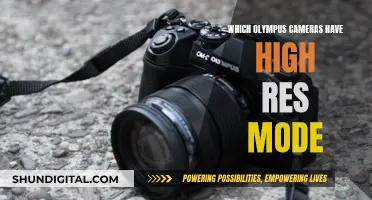
The Kodak 35 was the first 35mm camera manufactured by Kodak in the United States, introduced in 1938. The camera was developed in Rochester, New York, as Kodak anticipated that imports from its factory in Germany could be disrupted by the looming war. The Kodak 35 was offered in three different versions, varying in the lens and shutter offered. The camera's black body, rounded sides, lens/shutter unit, and top with two film advance wheels and a collapsible optical viewfinder give it a characteristic, antique look.
What You'll Learn

The Kodak 35 was introduced in 1938
The Kodak 35 was the first US-manufactured 35mm camera, and it had an antique look, inheriting design elements from earlier Kodak folding cameras. The camera's black body, rounded sides, lens/shutter unit, and top with two film advance wheels and a collapsible optical viewfinder gave it a characteristic look. The camera was crafted out of Bakelite, with numerous metallic panels, inserts, and fittings. The back of the camera was removable for easy film loading.
When the Kodak 35 was introduced, it was offered in three different versions, each with a distinct lens/shutter combination:
- Kodak Anastigmat 50mm f/5.6 with a three-speed Kodex shutter
- Kodak Anastigmat 51mm f/4.5 with a four-speed Diomatic shutter
- Kodak Anastigmat Special 51mm f/3.5 with a five-speed Kodamatic shutter
The original Kodak 35, introduced in 1938, did not have a rangefinder. However, after about two years, an improved version called the Kodak 35 Rangefinder was released, featuring a superstructure that housed a viewfinder and a separate rangefinder.
Unlocking Portrait Mode: Creative Camera Control
You may want to see also

It was the first 35mm camera manufactured by Kodak in the US
The Kodak 35 was introduced in 1938 as the first 35mm camera manufactured by the Eastman Kodak Company in the United States. The Kodak Retina series, earlier 35mm models, were being made in Germany starting in 1934, but as World War II loomed, Kodak decided to develop a 35mm camera that wouldn't rely on imported components. The Kodak 35 was developed in Rochester, New York, and was priced at $33.50 USD with an f/3.5 lens, $24.50 with an f/4.5 lens, and $14.50 with an f/5.6 lens. The camera was solidly crafted out of Bakelite, with numerous metallic panels, inserts, and fittings. The back of the camera was removable for film loading.
The Kodak 35 had an antique look, with a black body, rounded sides, a lens/shutter unit, and a collapsible optical viewfinder. The top of the camera featured two film advance wheels. When it was first introduced, the Kodak 35 was offered in three different versions, varying in the lens/shutter offered:
- Kodak Anastigmat 50mm f/5.6 (3-element triplet) in a three-speed Kodex shutter (1/25 to 1/100 plus T and B) with black knobs and finder
- Kodak Anastigmat 51mm f/4.5 (3-element triplet) in a four-speed Diomatic shutter (1/25 to 1/150 plus T and B) with chrome knobs/finder and accessory shoe
- Kodak Anastigmat Special 51mm f/3.5 (4-element Tessar design) in a five-speed Kodamatic shutter (1/10 to 1/200 plus T and B) with chrome knobs/finder and accessory shoe
During World War II, the Kodak 35 was produced in an olive drab version for military use. After the war, the black knobbed f/5.6 version was discontinued, and the Kodak 35 was reintroduced with flash synchronisation in two new versions:
- Kodak Anastigmat 51mm f/4.5 (3-element triplet, redesignated Anaston in 1947) in a four-speed Flash Diomatic Shutter with speeds from 1/25 to 1/150 sec plus B and T
- Kodak Anastigmat Special 51mm f/3.5 (4-element Tessar design) in a five-speed Flash Kodamatic shutter 1/10 to 1/200 plus T and B
Charging Your Canon Powershot SX40: A Quick Guide
You may want to see also

The Kodak Retina series were earlier 35mm models made in Germany
The Kodak Retina series was a long-running line of German-built 35mm cameras, produced from 1934 until 1969. The series included a variety of folding and non-folding models, including the Retina Reflex single-lens reflex camera. Retina cameras were known for their compact size, high quality, and low cost compared to competitors.
The first Retina, Nr. 117, was introduced in late July 1934. The successive model, Nr. 118 Retina, followed in 1935 with minor modifications. The Retina I was produced in several different variations from 1934 to 1950, and the last folding Retina cameras were produced in the 1950s. The folding Kodak Retinas featured a short self-erecting bellows, lens board, and folding metal door/cover.
Kodak also offered a companion line of less expensive Retinette cameras, with similar looks and functions. The Retina Reflex SLR camera systems were introduced in 1957 and produced in several iterations until 1966.
The early Retina series attempted to be a quality product, designed and built in Germany by the Nagel Camerawerks, which Kodak bought in 1931. The Nagel-era Retinas were known for their German quality. However, in the 1960s, Kodak cheapened the quality and mass-produced the later non-folding Retinettes and SLR Retinas, which were not as well-received as the early rangefinder models.
Camera Raw Compatibility with Adobe CS6
You may want to see also

The Kodak 35 was sold for $33.50 USD with the f/3.5 lens
The Kodak 35 was the first 35mm camera manufactured by the Eastman Kodak Company in the United States. It was introduced in 1938 as the first US-manufactured 35mm camera from Eastman Kodak. The Kodak 35 was developed in Rochester, New York, due to the looming war that threatened to disrupt imports from the Kodak factory in Germany.
The Kodak 35 was an evolution of the Kodak Retina series, which were 35mm models made in Germany starting in 1934. The new camera was designed with a unique look, featuring a black body with rounded sides, a lens/shutter unit, and a top with two film advance wheels and a collapsible optical viewfinder. The camera was crafted using Bakelite, with several metallic panels, inserts, and fittings. The back of the camera was removable for easy film loading.
When the Kodak 35 was first introduced, it was offered in three different versions, each with a distinct lens/shutter combination. These initial versions included:
- Kodak Anastigmat 50mm f/5.6 lens with a three-speed Kodex shutter
- Kodak Anastigmat 51mm f/4.5 lens with a four-speed Diomatic shutter
- Kodak Anastigmat Special 51mm f/3.5 lens with a five-speed Kodamatic shutter
The Kodak 35 originally went on sale in 1938 with a list price of $33.50 USD for the version with the f/3.5 lens. The other versions were priced at $24.50 for the f/4.5 lens and $14.50 for the f/5.6 lens. Despite its innovative features, the Kodak 35 was consistently outsold by the Argus C series, which was significantly more affordable and offered a coupled rangefinder.
To compete with Argus, Kodak introduced the Kodak 35 RF in 1940, which featured a coupled rangefinder. However, even with these improvements, the Kodak cameras were unable to surpass Argus' market dominance.
HP Camera Battery Drain: Tips to Conserve Power
You may want to see also

The Kodak 35 Rangefinder is an improved version of the Kodak 35
The Kodak 35 Rangefinder is an improved version of the original Kodak 35, which was introduced in 1938 as the first US-manufactured 35mm camera from Eastman Kodak Company. The Kodak 35 Rangefinder was launched two years later, featuring a new superstructure that included a viewfinder and a separate rangefinder. This model is often referred to as the "RF model" or the "gear-coupled RF version".
The Kodak 35 Rangefinder has a centrally positioned eyepiece for the viewfinder. The rangefinder optics are connected to an external mechanism, which senses the height of a milled cam at the periphery of the lens barrel. Both the viewfinder and rangefinder eyepieces, as well as the lens coupling, are styled similarly to Leica cameras. However, the way in which the lever operates on the lens barrel is different. The rangefinder window on the left side reveals a horizontally split image, and by turning the focusing wheel, the lower image part can be shifted sideways. This allows photographers to align vertical features in the motive with the split in the rangefinder image, ensuring sharpness on the film.
The Kodak 35 Rangefinder was available with various shutter and lens combinations during its production run from 1940 to 1951. The early versions featured the Kodak Anastigmat Special uncoated lens, while the later production from 1947 to 1951 included the 50mm coated Anastar lens. The camera body is constructed with Bakelite and steel, giving it a solid feel. The removable back is similar to the Argus C series cameras. The shutter mechanism is self-cocking as the film is advanced, and the small lever on the side of the lens mount serves as the trigger.
The Kodak 35 Rangefinder also has a film advance release button on top, which must be pressed after each exposure to advance to the next frame. The wind knob should be turned until it clicks to ensure proper film advancement. The camera's unique design makes it challenging to test the shutter without opening the camera or removing the top of the lens assembly. The lens housing can be disassembled by removing screws from the focus dial and the base of the lens, providing access to the shutter cocking mechanism and other internal parts.
The Kodak 35 Rangefinder is a straightforward camera to work on, making it a perfect choice for those interested in camera repair and maintenance. Its simplicity, durability, and ability to produce quality photographs contribute to its appeal for photography enthusiasts.
Traveling with Camera Batteries: A Guide to Safe Packing
You may want to see also







